Paris Saint-Germain will hope to have secured one of the bargains of the transfer window with the €20 million signing of Pablo Sarabia from Sevilla. With 23 goals and 15 assists for the Spanish side last season, few players will be available on the market with such a return at a lower price. So much so in fact, that PSG were persuaded to pay €2 million more than his release clause required in order to keep the relationship with Sevilla smooth.
The tactical analysis in this scout report will consider why he is such a promising signing for the French champions. Having competed with the likes of Lionel Messi, Luis Suarez and co. in terms of goals and assists throughout 2018/19, Sevilla will be losing a star but it is about time that Sarabia competes for elite trophies and looks to force his way into the reckoning of the very best in the game.
Where will he fit in?
This could largely depend upon what Neymar Junior does next. Sarabia performs best when given substantial freedom to roam, something that may not be so easy to come by at Parc des Princes. However, he may well fit in on the right flank where there has been a shortage of options for Thomas Tuchel at times in his debut season in Ligue Un.
In 2018/19, that is exactly where Sarabia was most frequently fielded, looking to make the right wing position his own. At Sevilla, that required more defensive responsibilities, looking to coordinate with his wing-back, most regularly Jesus Navas, but at PSG he would be liberated of that. Instead, he will be afforded more freedom to burst forwards. The challenge will be how he adapts to sticking out wide.
Whilst his role has primarily been on the right, as shown by his heat map, he does often drift into the middle of the field to look to exploit spaces and gaps which are not picked up by the midfield three or a striker. With the likes of Neymar and Kylian Mbappe alongside him, the role of floating to explore space has already been taken up.
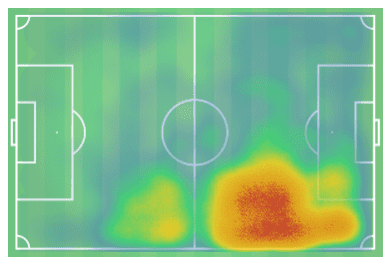
However, that is where one of his biggest strengths comes in to play in the form of his flexibility. Particularly if Neymar were to depart and leave a gap on the left flank, this could come into play. Last season alone, he played in seven different positions, all across the front line, in central midfield and even at full-back on both flanks. Previously, he would do so significantly more, with his game time in 2016/17 being almost evenly split across both wings. Now, he has specialised on the right flank, but with such competition for spaces, his flexibility could be highly valued.
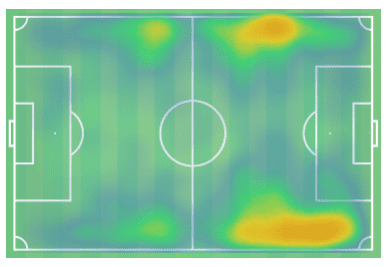
Whilst it is not his best position, he has also filled in as both a wing-back and a full-back on both flanks for Sevilla. Sarabia must be cautious not to become somewhat of a utility man for PSG. At Sevilla, he established himself rapidly and has never fallen into that trap, but has instead been forced into areas where he is not as comfortable simply to accommodate his quality. At PSG, he is a more natural fit but must find the form quickly enough to prove his point right from the off.
Creativity
Only Sarabia provided more assists than Lionel Messi in La Liga last season, becoming the first non-Barcelona player to top that table since his new team-mate Angel Di Maria did so in 2014 for Real Madrid and the first non-Clásico player to do so since David Villa in 2007. Sarabia has grabbed the headlines over the past season for his performance in front of goal, but he is far from a selfish player and it is his all-round attacking contribution with a high number of assists that has surely convinced PSG to fork out the cash needed to sign him this summer.
One area where he poses the biggest threat is on the counter when his runs pick holes in opposition defences. Whenever Sevilla look to get on the counter, he will often be one of those to cover the most ground as he breaks from deep and looks to catch up with play. By starting in a deeper position, he allows rival defenders to be distracted and drift centrally, allowing him greater space to bomb down the flank and cause chaos.
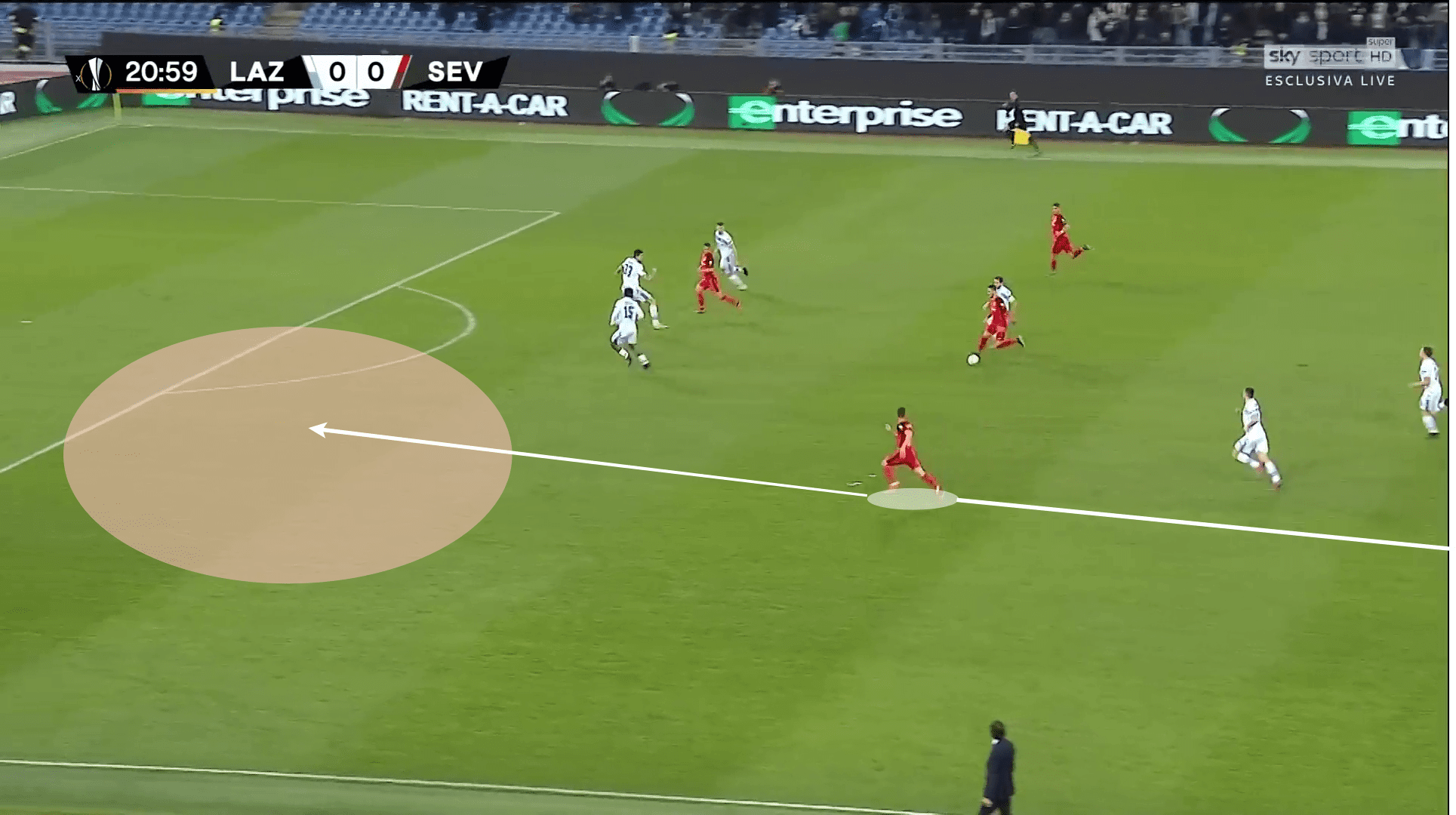
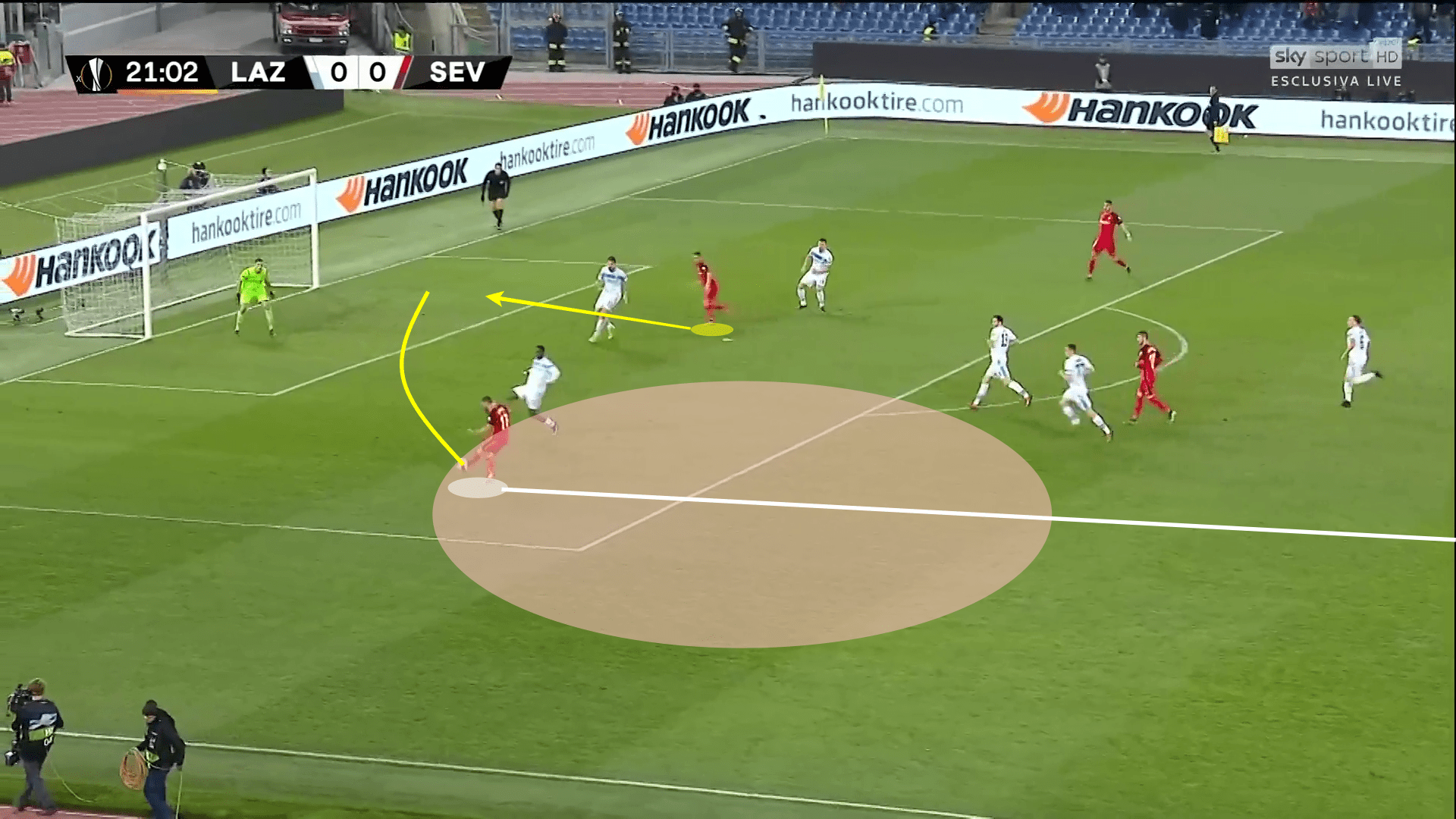
That was the case against Lazio in the above example, where he times his run well to collect the ball on the edge of the box and within a few touches cross it into the path of an on running centre-forward. Sarabia has become an expert at identifying where full-backs can be distracted or drift centrally and then pouncing at the right time to exploit the gaps that they leave in behind, always looking to pick out the runners alongside him to set them up.
He poses a threat when carrying the ball too. Often, he will be found picking the ball up in a deep position and then carrying it forwards with pace, looking to spread the ball out wide. It has been a key outlet for Sevilla over the past season by spraying the ball out to him deep in their own half and watching him carry it forwards.
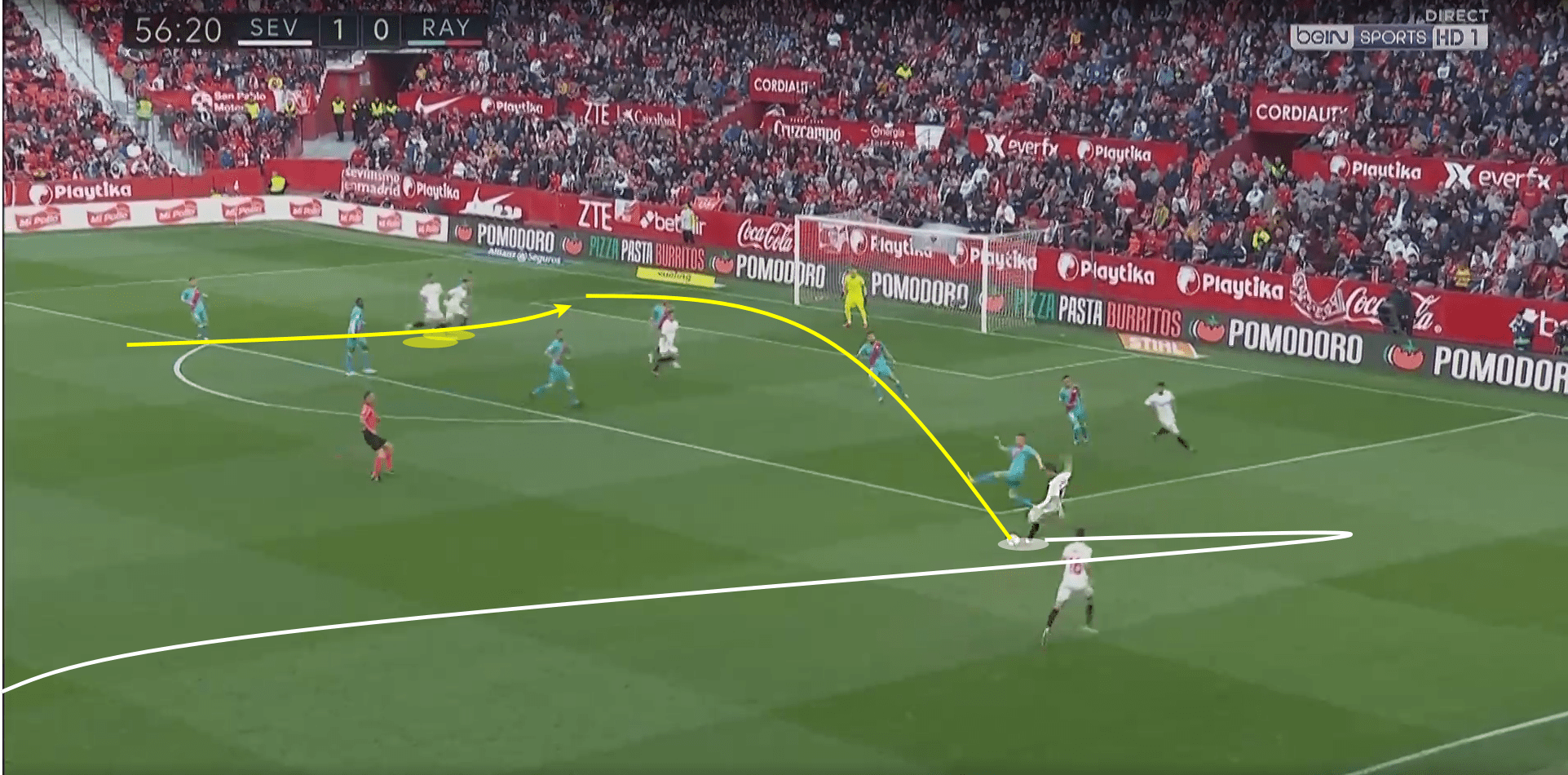
Finally, his crossing is also a major threat. As can be seen in the above example against Rayo Vallecano, his intelligence sees him continue his run down the flank, inviting the Rayo defence to settle deeper, before he cuts back and delivers the cross to the far post where there are two runners coming in. That is possible thanks to his impressive improvements in crossing, where his accuracy has improved by a substantial 10% across just two seasons to now reach 35%.
Whilst he makes fewer crosses than he once did, particularly at Getafe, you can now see that Sarabia has grown in his intelligence and will look to cross at the right time, continuing his dribble when it’s not appropriate or looking to play the short pass. Not only has this brought a wider diversity to his attacking contribution, but it has also allowed him to be more precise when he is playing a cross into the box.
Clinicality
Perhaps the most marked improvement in Sarabia’s game in recent years has been his clinicality in front of goal. Exceeding his xG by over five goals last season, he has finally added the goals that would be expected from an offensive midfielder of his quality. Notably, he achieved 46.5% of his shots on target, a figure only beaten once in his career when the figure was 48.4% in 2015/16, but with one-fifth of the number of shots that he registered in 2018/19. Not only is Sarabia growing in confidence in front of goal, but he is becoming more clinical too.
By getting in at the far post with his attacks, he will often find himself taking his shots at the end of crosses, or alternatively by running down the flanks and then cutting inside to take a shot. At times, he has shown signs of wastefulness by taking efforts from distance, but that has to some extent been a testament to his growing confidence as the campaign has gone by.
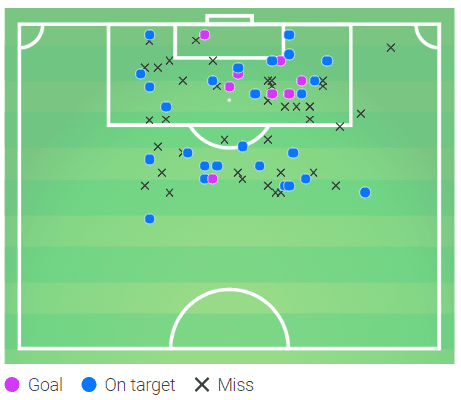
Where he has undoubtedly been the biggest threat has been with simple finishes on the end of crosses. Sarabia performs particularly well up against wing-backs, where he can exploit the space that they leave in behind to outsmart them on the run, using his pace to drift off towards the far post. As the season passed by, it became a tactic used more and more frequently by Sevilla to look to pick him out at the far post. It worked a treat in terms of tactics, as was evident against Real Betis in the derby, but also explains why he scored many of his goals against the stronger sides in La Liga where their more expansive and attacking style allowed him to gain greater freedom to find that space on the counter.
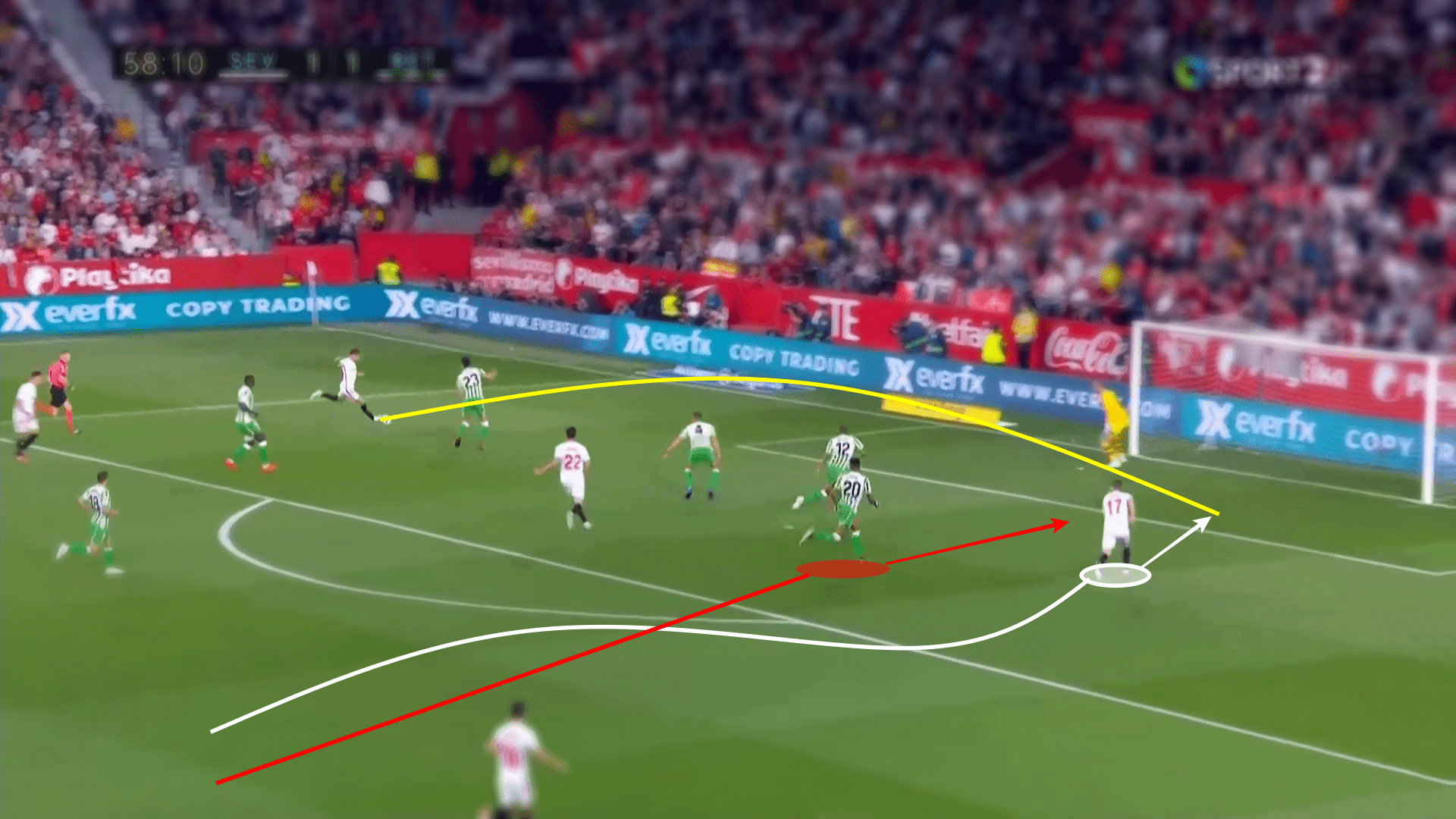
The challenge, and where the value for money really depends, will be whether PSG can get Sarabia to sustain that goalscoring form. 2018/19 was only the second time in the 27-year-old’s career that he reached double figures for goals in all competitions in a single season at first-team level, having scored 11 in 2016/17.
The manner of his goals, attacking the far post effectively, would suggest that they have come from a change in approach a new technique, rather than simply improving his finishing which is more likely to fluctuate. However, if he does not get regular game time and in a new environment, less centred around his style of play, will still make this difficult. Sarabia must continue to make those runs and have the confidence to gamble on a cross coming in and quickly integrate with his team-mates so that they can pick him out just as they have at Sevilla.
Defensive contribution
Where Sarabia may differ from his new team-mates in the offensive roles and offer real value in terms of tactics is in his defensive contribution. As has been touched upon previously, he has at times stepped in as a make-shift full-back or wing-back and performed well which is a testament to what he contributes to the defensive phase even when he is in a more advanced position.
His primary contribution at Sevilla has always been at the peak of a pressing triangle, immediately pouncing whenever the ball is moved wide to shut down the angles, with Sarabia coming from behind to apply the pressure and look to force the wide midfielder into a mistake or engage in a duel. That’s exactly what happened in the below example against Saul Niguez of Atletico Madrid and Sarabia was able to win the ball back, feed it into his midfield and immediately spark a counter-attack.
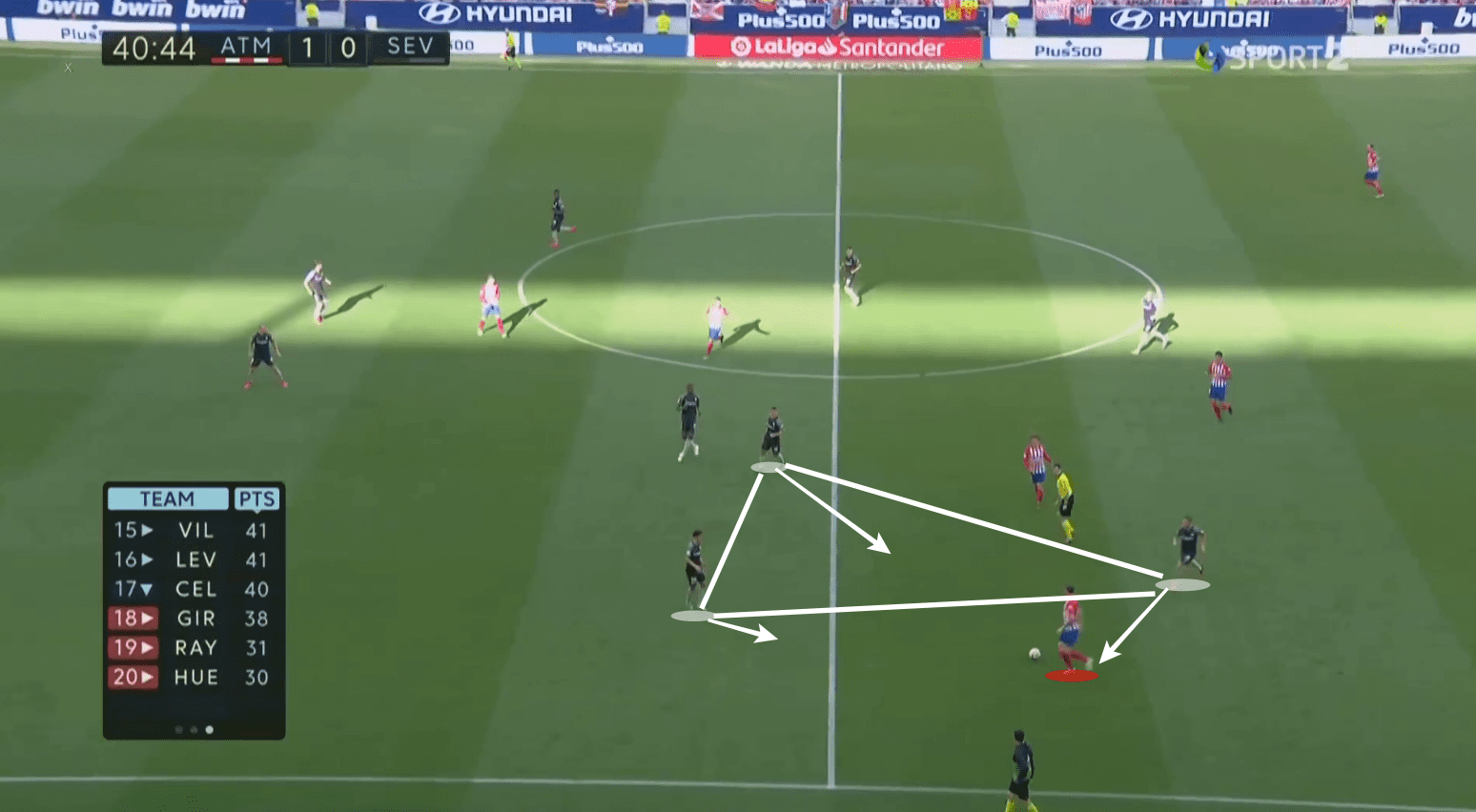
Registering 6.84 defensive duels per game, compared to 4.29 for Neymar, 3.65 for Angel Di Maria and 4.05 for Julian Draxler in similar positions for PSG, it is clear that Sarabia will bring something new to PSG in this regard. His work rate and defensive contribution will be interesting to follow, where it will be less crucial in domestic fixtures but could become key in European ties where PSG’s front-line have too often let them down by simply failing to act as the first line of defence. Sarabia could be the impetus to spark a change.
Will he be able to replicate his form in France?
Everything would point towards yes. To put it simply, Sarabia was one of the few players to maintain a somewhat consistent level for Sevilla last season, both domestically and in Europe. Sarabia has only faced French opposition twice in the past four seasons, coming up against Olympique Lyonnais in the Champions League where he was rested for one game and performed adequately in the return fixture.
Sarabia has adapted rapidly between two significantly differing styles before when he moved from Getafe, a more route one and direct approach, to Sevilla, where the game is built more around wing play and counter-attacking. In both instances, he has settled in quickly and found a way to shine. Paris will bring an all-new challenge to him, featuring in another country with all that it brings on and off the field, but few players in La Liga would be more adept. With little interest from the big guns in La Liga, a move abroad is the logical next step in Sarabia’s career.
What’s his weakness?
In some regards, Sarabia’s strength of his flexibility may be his weakness. Under Thomas Tuchel, the best thing that Sarabia can hope for is a settled and regular position or role and avoid the constant chopping and changing he experienced under both Pablo Machin and Joaquin Caparros last season. Caparros in particular frequently looked to play him as one of a central midfield three, a role which limited his best features and reduced his impact on the game.
Where Sarabia has excelled and become more dangerous in the final third over the past year or so has been in the timing of his runs and moves forward. However, when deployed in the middle of the park he is put under more pressure and afforded less space. The result would often be that he would be forced to turn back on himself, often without the wide runner providing an option down the flank. With Sevilla’s wing-back system, it was used to shoehorn Sarabia into the side at times and did not get the best out of him. In Paris, it’s essential that he is used to his strengths.
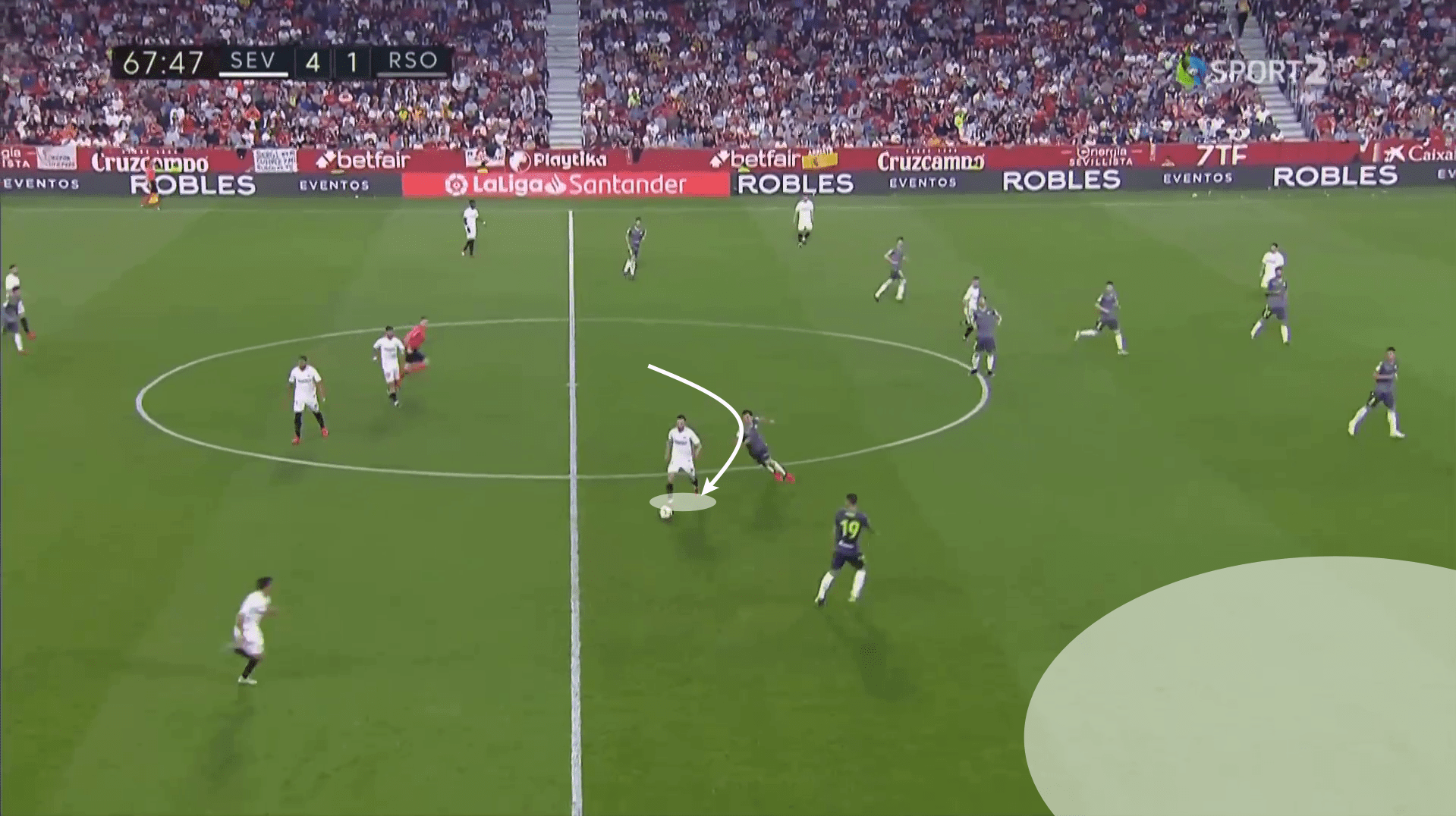
One other area where Sarabia may be perceived to have a weakness is his lack of experience is at the very highest level. Despite his form at club level, he has never earned international recognition at senior level and is yet to play for a club which is a real contender for either their domestic league or Champions League crown. Sevilla’s form in the Europa League means that he’s well aware of the ins and outs of knock-out football at the European stage. As PSG continue to look for the missing link to help them lift the Champions League, Sarabia is a signing of the quality of that level but without the experience of ever having come close.
Conclusion
With all of these questions asked and answered, there can only be one left: If he’s so good, why was he so cheap? Much of it comes down to the fact that Sarabia joined Sevilla on even more of a bargain deal for just €400,000 only three years ago. That allowed his agent to sneak in a release clause which seemed realistic at the time and now looks a bargain. PSG could have signed themselves a real talent in Sarabia, one who clearly has the attacking flair that the French side are looking for. He may not quite have the experience or star factor that Parisian fans have become accustomed too, but he is a player built for their offensive style and one who could pose a major threat domestically and in Europe.
If you love tactical analysis, then you’ll love the digital magazines from totalfootballanalysis.com – a guaranteed 100+ pages of pure tactical analysis covering topics from the Premier League, Serie A, La Liga, Bundesliga and many, many more. Buy your copy of the June issue for just ₤4.99 here, or even better sign up for a ₤50 annual membership (12 monthly issues plus the annual review) right here.

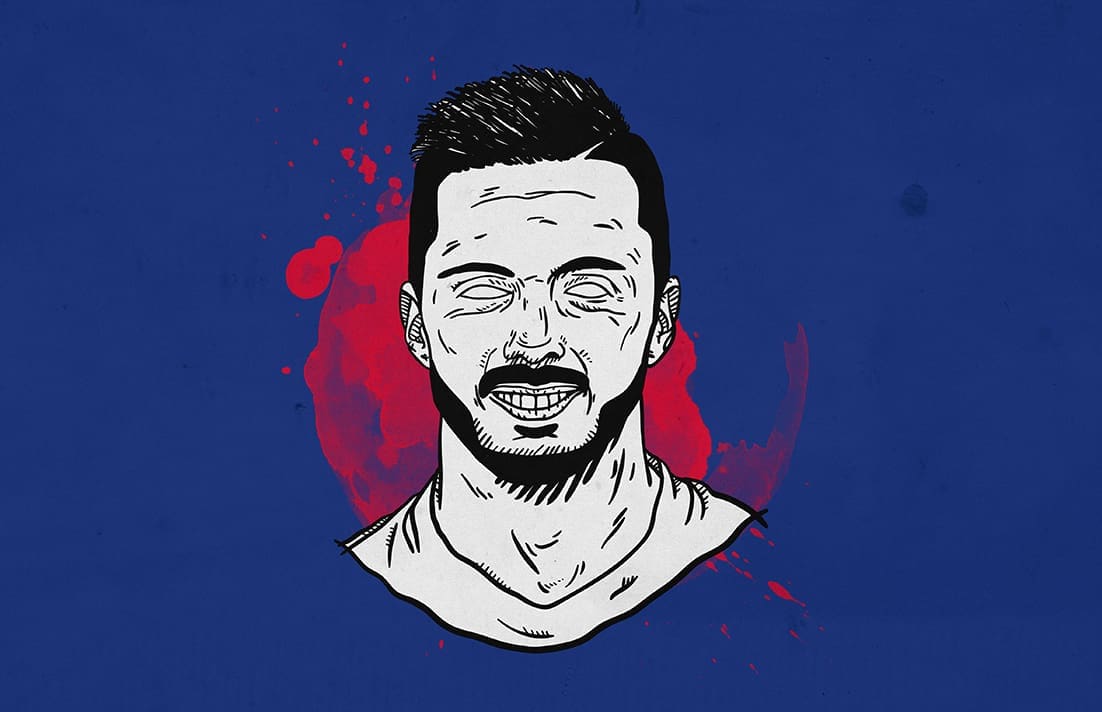



Comments